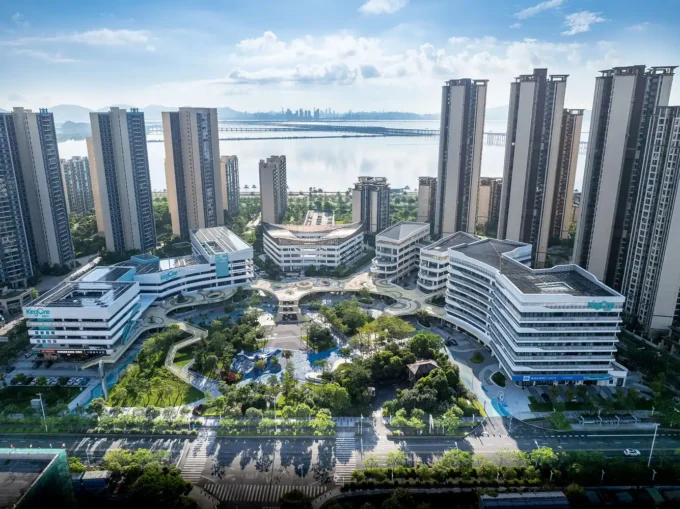Groot Hartje is an architecturally thoughtful residential ensemble uniquely positioned on a complex site in Eindhoven—nestled between the PSV soccer stadium, the railway line, and the finely grained Philipsdorp neighborhood. This project forges a new, vital connection between the city center and the emerging Strijp S development, seamlessly bridging diverse urban scales while respecting the context’s layered history and character.
A key feature of the site is the preservation and careful integration of an old, majestic plane tree on the corner, anchoring the ensemble in its place. Complementing this green legacy is the “Benjamin,” a group of four distinctive green ceramic townhouses at the edge of the development, paying homage to the adjacent Philipsdorp neighborhood. Together, these elements establish a high-density residential environment that balances the vitality of urban life with a relaxed, verdant atmosphere.

Creating a Recognizable and Harmonious Place
The design strategy responds directly to the site’s challenges and opportunities by respecting surrounding building scales and urban flows. The main volume aligns with the medium-rise residential blocks near the stadium, forming a strong urban wall along the street that effectively buffers and shields the quieter, private inner gardens.
By dividing the project into three distinct building volumes, the architects ensure a clear and human-scale experience while enabling peaceful garden spaces away from the street noise and hustle. Notably, the existing entrance and exit of the stadium’s parking garage have been cleverly integrated into the design, maintaining functionality without compromising the architectural coherence.
The four “Benjamin” townhouses mark a key urban node where the development meets the small-scale Lijsterbesbuurt neighborhood, offering a visually striking and meaningful transition.

Facade Design: Balance Between Activity and Calm
Despite its location in a bustling environment, the building’s facades achieve a sense of calm and order. Variation and coherence are delicately balanced through subtle interventions: recessed brick surfaces create nuanced depth, horizontal concrete bands add rhythm, and balconies are regularly spaced to maintain visual harmony.
This approach respects the site’s energetic context while offering a peaceful architectural expression that enhances residents’ comfort and urban identity.
The Benjamin: A Unique Ceramic Landmark
At the interface with the Lijsterbesbuurt, the four townhouses stand out with their green ceramic facades, which feature two shades of green arranged in a barcode pattern. This design references “040 De Jonghlaan”—a creative nod combining Eindhoven’s telephone area code and the street name.
Beyond being a local identifier, the barcode motif symbolically connects to Eindhoven’s industrial heritage, from its roots as the “City of Light” to its current status as a high-tech campus, reflecting the city’s evolution and digital future.

Three Distinct Landscapes Within One Development
S&P Landscape Architecture shaped the outdoor environment into three distinct yet interconnected landscapes:
-
Public Park Garden: Situated on the corner and enclosed by an elegant fence, this lush, flowery park embraces the old plane tree, providing a welcoming green oasis visible from the street.
-
Residents’ Garden: Elevated one level above the public garden, this semi-private space includes a glass greenhouse and generous decks, offering residents flexible communal areas for leisure and gatherings.
-
Vertical Landscape: Climbing plants scale the facades, while green sedum roofs collect and retain rainwater, contributing to ecological performance and aesthetic richness.
Sustainability at the Core
Despite the project’s complex urban location, sustainability is a key pillar of the design. Green roofs and facades mitigate heat and manage rainwater, while photovoltaic (PV) panels contribute to on-site renewable energy generation. Retaining the large plane tree enriches the local ecology and spatial experience, supporting biodiversity and providing natural shade.
The collective inner gardens enhance social sustainability by fostering community and offering green respite within a dense urban fabric.

Resident Experience: Living in Groot Hartje
Residents Joost and Tess share their appreciation for the design’s success:
“We think the design of our residential building is very successful. The green townhouses are a nice special feature that gives the place character and identity. The communal areas are beautifully finished and provide great space for meeting neighbors. Even though we are near two busy roads, the layout—with a communal park in front—creates a quiet, secure entrance. The direct access from the bike shed to the cycling path behind the building is very convenient.
We love our apartment and enjoy living here. Thanks to the large floor-to-ceiling windows, our home is bright and offers great views over the city every evening. The large balconies are perfect for relaxing outside on warm evenings.”
Groot Hartje exemplifies how careful design can harmonize dense urban living with nature, community, and sustainability, creating a vibrant, recognizable new neighborhood in Eindhoven.
Photography: LEVS architecten
- Adaptive Urban Design
- Barcode Facade Pattern
- biophilic design
- Ceramic Townhouses Eindhoven
- Community Architecture
- Contemporary Dutch Residential Architecture
- Eindhoven Housing Development
- Green Facades
- green roof technology
- Groot Hartje Eindhoven
- Landscape Integration
- Mixed-Use Residential Design
- Noise Mitigation Architecture
- Photovoltaic Panels
- sustainable neighborhoods
- Sustainable Residential Architecture
- S\&P Landscape Architecture
- Urban Density and Green Spaces
- Urban Living Eindhoven
- Vertical Greenery





















































Leave a comment